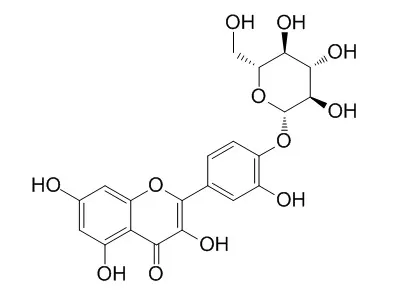| In vitro: |
| http://europepmc.org/article/MED/25397870 | | Delineation of the role of glycosylation in the cytotoxic properties of quercetin using novel assays in living vertebrates.[Reference: WebLink] | Quercetin is a plant-derived flavonoid and its cytotoxic properties have been widely reported. However, in nature, quercetin predominantly occurs as various glycosides. Thus far the cytotoxic activity of these glycosides has not been investigated to the same extent as quercetin, especially in animal models.
METHODS AND RESULTS:
In this study, the cytotoxic properties of quercetin (1), hyperoside (quercetin 3-O-galactoside, 2), isoquercitrin (quercetin 3-O-glucoside, 3), quercitrin (quercetin 3-O-rhamnoside, 4), and Spiraeoside (quercetin 4'-O-glucoside, 5) were directly compared in vitro using assays of cancer cell viability. To further characterize the influence of glycosylation in vivo, a novel zebrafish-based assay was developed that allows the rapid and experimentally convenient visualization of glycoside cleavage in the digestive tract. This assay was correlated with a novel human tumor xenograft assay in the same animal model. The results showed that 3 is as effective as 1 at inhibiting cancer cell proliferation in vivo. Moreover, it was observed that 3 can be effectively deglycosylated in the digestive tract.
CONCLUSIONS:
Collectively, these results indicate that 3 is a very promising drug candidate for cancer therapy, because glycosylation confers advantageous pharmacological changes compared with the aglycone, 1. Importantly, the development of a novel and convenient fluorescence-based assay for monitoring deglycosylation in living vertebrates provides a valuable platform for determining the metabolic fate of naturally occurring glycosides. | | Helvetica chimica acta, 1989, 72(5):985-992. | | Notiz über Ellagitannine und Flavonol‐glycoside aus Rosenblüten.[Reference: WebLink] |
METHODS AND RESULTS:
Petals from two garden roses proved to be very rich in ellagitannins and flavonol glycosides. Rutin (1), Spiraeoside (2), quercitrin (3), isoquercitrin (4), nicotiflorin (5), eugeniin (6), rugosin A (7), rugosin D (10), casuarictin (8), and tellimagrandin I (9) were isolated. Spiraeoside, at physiological pH, exerts a pronounced stabilisation of the anthocyanin colour with enhancement of extinction and bathochromic shift of the absorption maximum in the visible range.
CONCLUSIONS:
The abundance of gallic‐acid derivatives 6–10 is in contrast to the apparent inability of rose flowers to produce anthocyanins with a trihydroxylated ring B, a prerequisite in breeding true blue‐coloured roses. | | Records of Natural Products,2014,8(3):286-289. | | New Inhibitors of the DENV-NS5 RdRp from Carpolepis laurifolia as Potential Antiviral Drugs for Dengue Treatment.[Reference: WebLink] |
Since a few decades the dengue virus became a major public health concern and no treatment is available yet. In order to propose potential antidengue compounds for chemotherapy we focused on DENV RNA polymerase (DENV-NS5 RdRp) which is specific and essential for the virus replication. Carpolepis laurifolia belongs to the Myrtaceae and is used as febrifuge in traditional kanak medicine. Leaf extract of this plant has been identified as a hit against the DENV-NS5 RdRp.
METHODS AND RESULTS:
Here we present a bioguided fractionation of the leaf extract of C. laurifolia which is also the first phytochemical evaluation of this plant. Five flavonoids, namely quercetin (1), 6-methylapigenin-7-methylether (2), avicularin (3), quercitrin (4) and hyperoside (5), together with betulinic acid (6), were isolated from the leaf extract of C. laurifolia. All isolated compounds were tested individually against the DENV-NS5 RdRp and compared with four other commercial flavonoids: isoquercitrin (7), Spiraeoside (8), quercetin-3,4’-di-O-glucoside (9) and rutin (10).
CONCLUSIONS:
Compounds 3, 4, 6, 8 and 10 displayed IC50 ranging from 1.7 to 2.1 μM, and were the most active against the DENV-NS5 RdRp. | | Bioorganic & Medicinal Chemistry Letters, 2015, 25(13):2702-2706. | | Inhibitors of melanogenesis in B16 melanoma 4A5 cells from flower buds of Lawsonia inermis (Henna).[Reference: WebLink] |
METHODS AND RESULTS:
The methanolic extract of Lawsonia inermis L. (henna) showed significant inhibitory activity toward melanogenesis in B16 melanoma 4A5 cells. Among the constituents isolated from the methanolic extract, luteolin, quercetin, and (±)-eriodictyol showed stronger inhibitory activity than the reference compound, arbutin. Several structure–activity relationships of the flavonoids were suggested, and OGlc < H = OH at the 3-position, OGlc < OH at the 4′-position, and the double bond between the 2- and 3-positions were important.
CONCLUSIONS:
The active constituents suppressed tyrosinase, tyrosinase related protein (TRP)-1, and TRP-2 mRNA expression. The suppression was considered as one of the mechanisms of action. Furthermore, the methanolic extract and several constituents, including luteoloside and Spiraeoside, showed anti-plasmin activity, which is considered to play a key role in UV-stimulated melanogenesis in human skin. |
|
| In vivo: |
| Biochemistry & Cell Biology-biochimie Et Biologie Cellulaire, 2015, 93(3):1-9. | | Spiraeoside inhibits mast cells activation and IgE-mediated allergic responses by suppressing phospholipase C-γ-mediated signaling.[Reference: WebLink] | Mast cells are responsible for IgE-mediated allergic responses through the secretion of various inflammatory cytokines and mediators. Therefore, the pharmacological regulation of mast cell activation is an important goal in the development of novel anti-allergic drugs.
METHODS AND RESULTS:
In this study, we found that Spiraeoside (SP) inhibits mast cell activation and allergic responses in vivo. SP dose-dependently inhibited the degranulation induced by IgE-antigen (Ag) stimulation in RBL-2H3 mast cells without cytotoxic effects. At the molecular level, SP reduced the Ag-induced phosphorylation and subsequent activation of phospholipase C-γ2 (PLC-γ2). Moreover, SP inhibited the phosphorylation of spleen tyrosine kinase (Syk), linker for activation of T cells (LAT), and downstream MAPKs, such as ERK1/2, p38, and JNK, eventually attenuating expression of TNF-α and IL-4. Finally, we found that SP significantly inhibited IgE-mediated passive cutaneous anaphylaxis (PCA) in mice.
CONCLUSIONS:
Taken together, our results strongly suggest that SP suppresses IgE-mediated mast cell activation and allergic responses by inhibiting Lyn-induced PLC-γ2/MAPK signaling in mast cells. |
|






 Cell. 2018 Jan 11;172(1-2):249-261.e12. doi: 10.1016/j.cell.2017.12.019.IF=36.216(2019)
Cell. 2018 Jan 11;172(1-2):249-261.e12. doi: 10.1016/j.cell.2017.12.019.IF=36.216(2019) Cell Metab. 2020 Mar 3;31(3):534-548.e5. doi: 10.1016/j.cmet.2020.01.002.IF=22.415(2019)
Cell Metab. 2020 Mar 3;31(3):534-548.e5. doi: 10.1016/j.cmet.2020.01.002.IF=22.415(2019) Mol Cell. 2017 Nov 16;68(4):673-685.e6. doi: 10.1016/j.molcel.2017.10.022.IF=14.548(2019)
Mol Cell. 2017 Nov 16;68(4):673-685.e6. doi: 10.1016/j.molcel.2017.10.022.IF=14.548(2019)